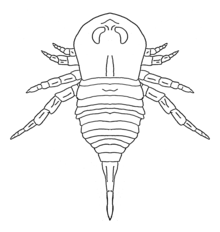
Eurypterids, often informally called sea scorpions, are a group of extinct arthropods that form the order Eurypterida. The earliest known eurypterids date to the Darriwilian stage of the Ordovician period 467.3 million years ago. The group is likely to have appeared first either during the Early Ordovician or Late Cambrian period. With approximately 250 species, the Eurypterida is the most diverse Paleozoic chelicerate order. Following their appearance during the Ordovician, eurypterids became major components of marine faunas during the Silurian, from which the majority of eurypterid species have been described. The Silurian genus Eurypterus accounts for more than 90% of all known eurypterid specimens. Though the group continued to diversify during the subsequent Devonian period, the eurypterids were heavily affected by the Late Devonian extinction event. They declined in numbers and diversity until becoming extinct during the Permian–Triassic extinction event 251.9 million years ago.

Stylonurina is one of two suborders of eurypterids, a group of extinct arthropods commonly known as "sea scorpions". Members of the suborder are collectively and informally known as "stylonurine eurypterids" or "stylonurines". They are known from deposits primarily in Europe and North America, but also in Siberia.

Chasmataspidids, sometime referred to as chasmataspids, are a group of extinct chelicerate arthropods that form the order Chasmataspidida. Chasmataspidids are probably related to horseshoe crabs (Xiphosura) and/or sea scorpions (Eurypterida), with more recent studies suggest that they form a clade (Dekatriata) with Eurypterida and Arachnida. Chasmataspidids are known sporadically in the fossil record through to the mid-Devonian, with possible evidence suggesting that they were also present during the late Cambrian. Chasmataspidids are most easily recognised by having an opisthosoma divided into a wide forepart (preabdomen) and a narrow hindpart (postabdomen) each comprising 4 and 9 segments respectively. There is some debate about whether they form a natural group.

Alkenopterus is a genus of prehistoric eurypterid classified as part of the family Onychopterellidae. The genus contains two species, A. brevitelson and A. burglahrensis, both from the Devonian of Germany.

Brachyopterus is a genus of prehistoric eurypterid of the family Rhenopteridae. It is one of the earliest known eurypterids, having been recovered from Middle Ordovician deposits in Montgomeryshire, Wales. Though other species have been assigned to it in the past, Brachyopterus is today recognized as containing one valid species, B. stubblefieldi.

Drepanopterus is an extinct genus of eurypterid and the only member of the family Drepanopteridae within the Mycteropoidea superfamily. There are currently three species assigned to the genus. The genus has historically included more species, with nine species having been associated with the genus Drepanopterus. Five of these have since been proven to be synonyms of pre-existing species, assigned to their own genera, or found to be based on insubstantial fossil data. The holotype of one species proved to be a lithic clast.

Campylocephalus is a genus of eurypterid, a group of extinct aquatic arthropods. Fossils of Campylocephalus have been discovered in deposits ranging from the Carboniferous period in the Czech Republic to the Permian period of Russia. The generic name is composed of the Greek words καμπύλος (kampýlos), meaning "curved", and κεφαλή (kephalē), meaning "head".

Kiaeropterus is a genus of prehistoric eurypterid classified as part of the Rhenopteridae family. Two species, both from the Silurian period, are known; K. cyclophthalmus from Scotland and K. ruedemanni from Norway.

Stylonurella is a genus of prehistoric eurypterid. It is classified within the Parastylonuridae family and contains three species, S. arnoldi and S. beecheri from the Devonian of Pennsylvania, United States and S. spinipes from the Silurian of Kip Burn, Scotland.
Stylonuroides is a genus of prehistoric eurypterid. The genus is classified as a stylonurine but more precise classification has proven difficult, with the genus remaining classified as incertae sedis within the suborder. The genus contains two species, S. dolichopteroides from the Silurian of Ringerike, Norway and S. orientalis from the Devonian of Lake Shunet, Southern Siberia.
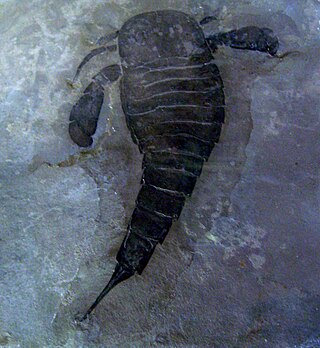
Eurypteroidea are an extinct superfamily of eurypterids. It contains three families and two genera of uncertain classification, Paraeurypterus and Pentlandopterus.

Stylonuroidea is an extinct superfamily of eurypterids, an extinct group of chelicerate arthropods commonly known as "sea scorpions". It is one of four superfamilies classified as part of the suborder Stylonurina.

The Parastylonuridae are a family of eurypterids, an extinct group of chelicerate arthropods commonly known as "sea scorpions". The family is one of two families contained in the superfamily Stylonuroidea, which in turn is one of four superfamilies classified as part of the suborder Stylonurina.
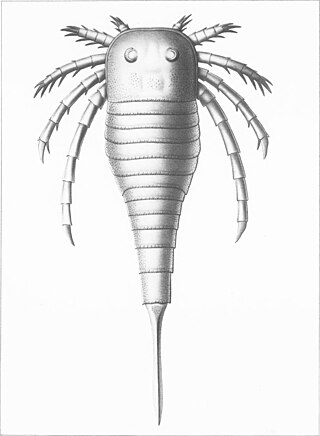
Kokomopteroidea is an extinct superfamily of eurypterids, an extinct group of chelicerate arthropods commonly known as "sea scorpions". It is one of four superfamilies classified as part of the suborder Stylonurina. Kokomopteroids have been recovered from deposits of Early Silurian to Late Devonian age in the United States and the United Kingdom.
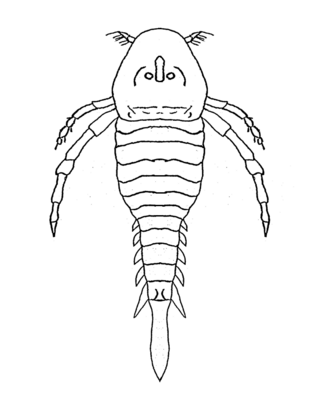
The Hardieopteridae are a family of eurypterids, an extinct group of chelicerate arthropods commonly known as "sea scorpions". The family is one of two families contained in the superfamily Kokomopteroidea, which in turn is one of four superfamilies classified as part of the suborder Stylonurina. Hardieopterids have been recovered from deposits of Early Silurian to Late Devonian age in the United States and the United Kingdom.

Hibbertopteridae is a family of eurypterids, an extinct group of aquatic arthropods. They were members of the superfamily Mycteropoidea. Hibbertopterids were large, broad and heavy animals unlike virtually every other group of eurypterids, which are commonly streamlined and lightweight. Their bizarre morphology is so unusual that they in the past have been thought to represent an entirely distinct order of chelicerates. Fossils of the family first appear in deposits of Middle Devonian age and the last known fossils representing hibbertopterids are known from deposits of Late Permian age. The hibbertopterids represent the last known living eurypterids, going extinct during the Permian–Triassic extinction event or shortly before.
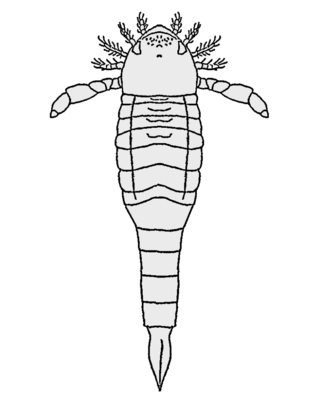
Waeringopteridae is a family of eurypterids, an extinct group of aquatic arthropods. The Waeringopteridae is the only family classified as part of the superfamily Waeringopteroidea, which in turn is classified within the infraorder Diploperculata in the suborder Eurypterina. The earliest known member of the group, Orcanopterus, has been recovered from deposits of Katian age and the latest known surviving member, Grossopterus, has been recovered from deposits of Siegenian age. The name Waeringopteridae is derived from the type genus Waeringopterus, which is named in honor of eurypterid researcher Erik N. Kjellesvig-Waering.

Eurypterina is one of two suborders of eurypterids, an extinct group of chelicerate arthropods commonly known as "sea scorpions". Eurypterine eurypterids are sometimes informally known as "swimming eurypterids". They are known from fossil deposits worldwide, though primarily in North America and Europe.

Mycteropoidea is an extinct superfamily of eurypterids, an extinct group of chelicerate arthropods commonly known as "sea scorpions". It is one of four superfamilies classified as part of the suborder Stylonurina. Mycteropoids have been recovered from Europe, Russia, South America and South Africa. Mycteropoid specimens are often fragmentary, making it difficult to establish relationships between the included taxa. Only two mycteropoid taxa are known from reasonable complete remains, Hibbertopterus scouleri and H. wittebergensis.
Leiopterella is a genus of prehistoric eurypterid of the family Rhenopteridae. It contains one species, Leiopterella tetliei, from the Early Devonian of Nunavut, Canada. The name is said to be derived from the Greek leios and pteros. The proper word for wing in ancient Greek is however pteron (πτερόν). The species name honors Dr. O. Erik Tetlie for his contributions to the study of fossil eurypterids.


